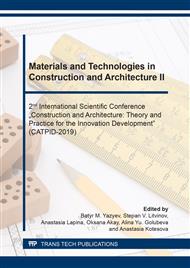[1]
T.V. Dmitrieva, V.V. Strokova, A.A. Bezrodnykh, Influence of the genetic features of soils on the properties of soil-concretes on their basis, Construction Materials and Products. 1 (1) (2018) 69 – 77.
DOI: 10.34031/2618-7183-2018-1-1-69-77
Google Scholar
[2]
M.Yu. Elistratkin, M.I. Kozhukhova, Analysis of the factors of increasing the strength of the non-autoclave aerated concrete, Construction Materials and Products. 1 (1) (2018) 59 – 68.
DOI: 10.34031/2618-7183-2018-1-1-59-68
Google Scholar
[3]
A.N. Volodchenko, V.V. Strokova, Features of technology for producing constructional heat insulating cellular concrete based on nonconventional raw materials, Bulletin of BSTU named after V.G. Shukhov. 1 (2017) 138-143.
DOI: 10.12737/24193
Google Scholar
[4]
Yu.V. Pukharenko, D.G. Letenko, V.A. Nikitin, V.I. Morozov, Obtaining the nanomodifier for cement composites based on the dealtom, carbon nanotubes, Materials Physics and Mechanics. 31 (2017) 59-62.
Google Scholar
[5]
L.A. Suleymanova, V.S. Lesovik, K.A. Kara, M.V. Malyukova, K.A. Suleymanov, Energy-efficient concretes for green construction, Research journal of applied sciences. 9 (12) (2014) 1087-1090.
Google Scholar
[6]
J. Brozovsky, Rebound hammer tests of calcium silicate bricks—effects of internal compressive stress on measurement results, Applied Mechanics and Materials. 595 (2014) 155-158.
DOI: 10.4028/www.scientific.net/amm.595.155
Google Scholar
[7]
Danielle Klimesch, Abhi Ray, Evaluation of phases in a hydrothermally treated CaO-SiO2-H2O system, Journal of Thermal Analysis and Calorimetry. 70 (3) (2002) 995-1003.
Google Scholar
[8]
S Bernstein, Thomas Karl Fehr, The formation of 1.13 nm tobermorite under hydrothermal conditions: 1. The influence of quartz grain size within the system CaO–SiO2–D2O, Progress in Crystal Growth and Characterization of Materials. 58 (2) 3 (2012) 84-91.
DOI: 10.1016/j.pcrysgrow.2012.02.006
Google Scholar
[9]
A.N. Volodchenko, N.P. Lukutsova, E.O. Prasolova, V.S. Lesovik, A.A. Kuprina, Sand-clay raw materials for silicate materials production, Advances in Environmental Biology. 8 (10) (2014) 949–955.
Google Scholar
[10]
N.I. Alfimova, E.E. Shadskiy, R.V. Lesovik, M.S. Ageeva, Organic-mineral modifier on the basis of volcanogenic-sedimentary rocks, International Journal of Applied Engineering Research. 10 (24) (2015) 45131-45136.
Google Scholar
[11]
A.A. Volodchenko, V.S. Lesovik, A.N. Volodchenko, L.H. Zagorodnjuk, Improving the efficiency of wall materials for «green» building through the use of aluminosilicate raw materials, International Journal of Applied Engineering Research. 10 (24) (2015) 45142-45149.
DOI: 10.4028/www.scientific.net/msf.974.20
Google Scholar
[12]
A.A. Volodchenko, V.S. Lesovik, A.N. Volodchenko, L.H. Zagorodnjuk, Influence of the inorganic modifier structure on structural composite properties, International Journal of Applied Engineering Research. 10 (19) (2015) 40617-40622.
Google Scholar
[13]
P. Kiliaris, C.D. Papaspyrides, Polymer layered silicate (clay) nanocomposites: An overview of flame retardancy, Progress in Polymer Science. 35 (2010) 902–958.
DOI: 10.1016/j.progpolymsci.2010.03.001
Google Scholar
[14]
A. Elamri, K. Abid, S. Dhouib, F. Sakli, Morphological and mechanical properties of nanoclay coated fabric, American Journal of Nano Research and Application, Special Issue: Nanocomposites Coating and Manufacturing. 3 (4) 1 (2015) 17-24.
Google Scholar


